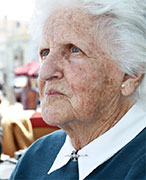
WEDNESDAY, Aug. 27, 2014 (HealthDay News) — Treating pre-cancerous skin spots with a type of light therapy may be more effective than the usual therapy — freezing the lesions with liquid nitrogen, a new study suggests.
Rough, scaly spots, called actinic keratoses, are often found on the scalp and face of people with fair complexions who’ve had a lot of sun exposure.
This review of prior research found that people who underwent the light treatment — called photodynamic therapy — were 14 percent more likely to have the lesion completely cleared three months later than those who had the freezing treatment known as cryotherapy.
Photodynamic therapy “is associated with better outcomes,” said Dr. Daniel Eisen, the study’s lead author. “It’s a relatively new treatment. Freezing has been done for decades.”
Eisen, director of aesthetic dermatology at the University of California, Davis Health System, said photodynamic therapy involves placing a light-sensitive liquid medication on a patient’s skin. The doctor shines a special light on the area, which activates the drug, killing the cells of the lesion.
He doesn’t think that photodynamic therapy will replace other treatments, however. “It’s going to be an additional option,” he said.
The treatment might be a good alternative for people who have 20 or 30 lesions, he said, since photodynamic therapy can treat them all at once, while cryotherapy deals with each lesion individually.
The report was published online Aug. 27 in JAMA Dermatology.
Dr. Harvey Lui, a Canadian dermatologist, is less of a fan of photodynamic therapy, which is also known as PDT.
“There are economic barriers, barriers related to the tolerability of the treatment, and barriers because the treatment is time consuming,” said Lui, head of dermatology and skin science at the University of British Columbia and co-author of an accompanying journal editorial.
Insurance coverage for photodynamic therapy is spotty, with some insurers covering it and others not, he explained. Photodynamic therapy is, however, covered by Medicare, the publicly funded insurance program for the elderly in the United States.
Photodynamic therapy also takes hours longer than cryotherapy, Lui said. “You have to apply the medication, have the patient wait and then shine the light on the skin. You stack that up against cryotherapy where I dispense liquid nitrogen on the lesion and I’m finished,” he said.
Also, photodynamic therapy “hurts when we activate the medication,” he said. “It seems for many patients, the pain is much more than what they experience with cryotherapy.”
Lui thinks a better, less expensive and less painful way of using the treatment is to apply the medication and let patients expose themselves to sunlight, which will activate the drug.
“We can use sunlight to treat a disease that was caused by sun exposure,” Lui said.
Dr. Jeffrey Salomon, an assistant clinical professor of plastic surgery at Yale University School of Medicine, said photodynamic therapy might also be an improvement on topical chemotherapy. This treatment — placing an anti-cancer medication on the skin lesions — “remains a workhorse for the treatment of skin with areas of actinic keratoses,” he said.
But the crusty wounds it causes can be unsightly for more than a month, he said. Photodynamic therapy “would be a welcomed treatment from that standpoint, as the downtime would be less,” he said.
For isolated actinic keratoses, Salomon said, almost anything works: laser, liquid nitrogen or a surgical shave.
“That being said, the recurrence of lesions is expected in the majority of patients with any of the treatments, due to sun damage to their entire exposed skin. These patients all require regular surveillance for new or recurrent lesions,” he said.
For the study, Eisen and colleagues analyzed four studies that compared photodynamic therapy with cryotherapy. These studies included 641 patients with a total of more than 2,000 lesions treated with cryotherapy and more than 2,000 treated with photodynamic therapy.
More information
For more on skin cancer, visit the American Cancer Society.
Copyright © 2025 HealthDay. All rights reserved.

